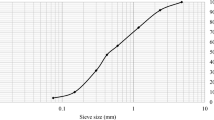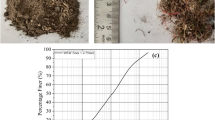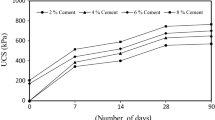Abstract
In order to improve the mechanical properties of dredged sludge, short polypropylene fibers were used as physical reinforcement, while cement and fly ash were used as chemical stabilizers. Different mass percentages of fiber (i.e., 0%, 0.05%, 0.1%, 0.2%, 0.4%, and 0.8%), cement (i.e., 15%, 20%, and 25%), and fly ash (i.e., 15% and 30%) were added to dredged sludge at two initial high water contents (i.e., 92% and 120%) and evaluated using physical experiments. The unconfined compression test was performed on samples after curing them for 28 days. The results show that inclusion of cement and fly ash can significantly increase the dry density and reduce the water content of dredged sludge after curing, consequently enhancing the unconfined compressive strength (UCS). It is found that chemical stabilization can increase the stiffness and brittleness of dredged sludge. However, excessively high fly ash fraction in the mix inhibits strength development in cement-stabilized dredged sludge. The inclusion of fiber decreases the initial stiffness and enhances the UCS, strain at failure, and residual strength of dredged sludge. The UCS increases with fiber content and then decreases slightly, with the optimal fiber content being 0.1%. Fiber reinforcement generates a distinct transition zone in the stress–strain curve, which enlarges with increasing fiber content. The contribution of fiber reinforcement to the strength of dredged sludge is more pronounced at relatively lower water content. The inclusion of fiber can temper the brittleness of chemical-stabilized dredged sludge with more ductile behavior by inducing a ‘bridging’ effect. This effect helps in reducing loading-induced cracking of the stabilized sludge.












Similar content being viewed by others
References
Akbulut S, Arasan S, Kalkan E (2007) Modification of clayey soils using scrap tire rubber and synthetic fibers. Appl Clay Sci 38(1–2):23–32
Asavapisit S, Naksrichum S, Harnwajanawong N (2005) Strength, leachability and microstructure characteristics of cement-based solidified plating sludge. Cem Concr Res 35(6):1042–1049
ASTM International (2016) ASTM D2166/D2166M-16. Standard test method for unconfined compressive strength of cohesive soil. ASTM International, West Conshohocken. https://www.astm.org/Standards/D2166
Cai Y, Shi B, Ng CWW, Tang CS (2006) Effect of polypropylene fibre and lime admixture on engineering properties of clayey soil. Eng Geol 87(3–4):230–240
Chan CM, Mizutani TA, Kikuchi Y (2011) Reusing dredged marine clay by solidification with steel slag: a study of compressive strength. Int J Civ Struct Eng 2(1):270–279
Chegenizadeh A, Nikraz H (2011) Investigation on strength of fiber reinforced clay. Adv Mater Res 261:957–963
Chindaprasirt P, Sinsiri T, Kroehong W, Jaturapitakkul C (2014) Role of filler effect and pozzolanic reaction of biomass ashes on hydrated phase and pore size distribution of blended cement paste. J Mater Civ Eng 26(9):04014057
Consoli NC, Prietto PD, Ulbrich LA (1998) Influence of fiber and cement addition on behavior of sandy soil. J Geotech Geoenviron Eng 124(12):1211–1214
Consoli NC, Casagrande MDT, Prietto PDM, Thomé AN (2003) Plate load test on fiber-reinforced soil. J Geotech Geoenviron Eng 129(10):951–955
Consoli NC, Bassani MAA, Festugato L (2010) Effect of fiber-reinforcement on the strength of cemented soils. Geotext Geomembr 28(4):344–351
Consoli NC, de Moraes RR, Festugato L (2011) Split tensile strength of monofilament polypropylene fiber-reinforced cemented sandy soils. Geosynth Int 18(2):57–62
Consoli NC, de Moraes RR, Festugato L (2013) Parameters controlling tensile and compressive strength of fiber-reinforced cemented soil. J Mater Civ Eng 25(10):1568–1573
Delage P, Marcial D, Cui YJ, Ruiz X (2006) Ageing effects in a compacted bentonite: a microstructure approach. Géotechnique 56(5):291–304
Devi D, Jempen B (2016) Shear strength behaviour of bamboo fiber reinforced soil. Int Res J Eng Technol 3(8):433–437
Feng SJ, Gao KW, Chen YX, Li Y, Zhang LM, Chen HX (2017) Geotechnical properties of municipal solid waste at Laogang landfill, China. Waste Manag 63:354–365
Festugato L, Fourie A, Consoli NC (2013) Cyclic shear response of fibre-reinforced cemented paste backfill. Geotech Lett 3(1):5–12
Festugato L, Menger E, Benezra F, Kipper EA, Consoli NC (2017) Fibre-reinforced cemented soils compressive and tensile strength assessment as a function of filament length. Geotext Geomembr 45(1):77–82
Hamzeh Y, Ashori A, Mirzaei B (2011) Effects of waste paper sludge on the physico-mechanical properties of high density polyethylene/wood flour composites. J Polym Environ 19(1):120–124
Horpibulsuk S, Rachan R, Chinkulkijniwat A, Raksachon Y, Suddeepong A (2010) Analysis of strength development in cement-stabilized silty clay from microstructural considerations. Constr Build Mater 24(10):2011–2021
Jafer H, Atherton W, Sadique M, Ruddock F, Loffill E (2018) Stabilisation of soft soil using binary blending of high calcium fly ash and palm oil fuel ash. Appl Clay Sci 152:323–332
Jiang H, Cai Y, Liu J (2010) Engineering properties of soils reinforced by short discrete polypropylene fiber. J Mater Civ Eng 22(12):1315–1322
Kaniraj SR, Havanagi VG (1999) Compressive strength of cement stabilized fly ash–soil mixtures. Cem Concr Res 29(5):673–677
Kelessidis A, Stasinakis AS (2012) Comparative study of the methods used for treatment and final disposal of sewage sludge in European countries. Waste Manag 32(6):1186–1195
Kumar A, Gupta D (2016) Behavior of cement-stabilized fiber-reinforced pond ash, rice husk ash–soil mixtures. Geotext Geomembr 44(3):466–474
Kumarr PR, Archana P (2017) Effect of CBR of black cotton soil reinforced with Recron fiber. Imp J Interdiscip Res 3(2):1093–1097
Kutanaei SS, Choobbasti AJ (2016) Triaxial behavior of fiber-reinforced cemented sand. J Adhes Sci Technol 30(6):579–593
Liu J, Wang G, Kamai T, Zhang F, Yang J, Shi B (2011) Static liquefaction behavior of saturated fiber-reinforced sand in undrained ring-shear tests. Geotext Geomembr 29(5):462–471
Lombardi F, Mangialardi T, Piga L, Sirini P (1998) Mechanical and leaching properties of cement solidified hospital solid waste incinerator fly ash. Waste Manag 18(2):99–106
Maher MH, Gray DH (1990) Static response of sands reinforced with randomly distributed fibers. J Geotech Eng 116(11):1661–1677
Michalowski RL, Čermák J (2003) Triaxial compression of sand reinforced with fibers. J Geotech Geoenviron Eng 129(2):125–136
Miller CJ, Rifai S (2004) Fiber reinforcement for waste containment soil liners. J Environ Eng 130(8):891–895
Mitchell JK, Soga K (2005) Fundamentals of soil behavior, 3rd edn. Wiley, Hoboken
Moghal AAB, Chittoori BC, Basha BM, Al-Shamrani MA (2017) Target reliability approach to study the effect of fiber reinforcement on UCS behavior of lime treated semiarid soil. J Mater Civ Eng 29(6):04017014
Narmluk M, Nawa T (2011) Effect of fly ash on the kinetics of Portland cement hydration at different curing temperatures. Cement and Concrete Research 41(6):579–589
Patel SK, Singh B (2017) Strength and deformation behavior of fiber-reinforced cohesive soil under varying moisture and compaction states. Geotech Geol Eng 35(4):1767–1781
Pinarli V, Karaca G, Salihoglu G, Salihoglu NK (2005) Stabilization and solidification of waste phosphate sludge using Portland cement and fly ash as cement substitute. J Environ Sci Health 40(9):1763–1774
Prabakar J, Sridhar RS (2002) Effect of random inclusion of sisal fibre on strength behaviour of soil. Constr Build Mater 16(2):123–131
Radovanović DĐ, Kamberović ŽJ, Korać MS, Rogan JR (2016) Solidified structure and leaching properties of metallurgical wastewater treatment sludge after solidification/stabilization process. J Environ Sci Health 51(1):34–43
Shahri Z, Chan CM (2015) On the characterization of dredged marine soils from Malaysian waters: physical properties. Environ Pollut 4(3):1–9
Son J, Yang HS, Kim HJ (2004) Physico-mechanical properties of paper sludge-thermoplastic polymer composites. J Thermoplast Compos Mater 17(6):509–522
Tang C, Shi B, Gao W, Chen F, Cai Y (2007) Strength and mechanical behavior of short polypropylene fiber reinforced and cement stabilized clayey soil. Geotext Geomembr 25(3):194–202
Tang CS, Shi B, Zhao LZ (2010) Interfacial shear strength of fiber reinforced soil. Geotext Geomembr 28(1):54–62
Tang CS, Shi B, Cui YJ, Liu C, Gu K (2012) Desiccation cracking behavior of polypropylene fiber-reinforced clayey soil. Can Geotech J 49(9):1088–1101
Tang CS, Li J, Wang DY, Shi B (2016) Investigation on the interfacial mechanical behavior of wave-shaped fiber reinforced soil by pullout test. Geotext Geomembr 44(6):872–883
Tran KQ, Satomi T, Takahashi H (2017) Study on strength behavior of cement stabilized sludge reinforced with waste cornsilk fiber. Int J Geomate 13(39):140–147
Wang D, Abriak NE, Zentar R (2017) Dredged marine sediments used as novel supply of filling materials for road construction. Mar Georesour Geotechnol 35(4):472–480
Yetimoglu T, Salbas O (2003) A study on shear strength of sands reinforced with randomly distributed discrete fibers. Geotext Geomembr 21(2):103–110
Zhang RJ, Santoso AM, Tan TS, Phoon KK (2013) Strength of high water-content marine clay stabilized by low amount of cement. J Geotech Geoenviron Eng 139(12):2170–2181
Zhang RJ, Lu YT, Tan TS, Phoon KK, Santoso AM (2014) Long-term effect of curing temperature on the strength behavior of cement-stabilized clay. J Geotech Geoenviron Eng 140(8):04014045
Acknowledgements
This work was supported by the National Natural Science Foundation of China (grant nos. 41572246 and 41772280), Natural Science Foundation of Jiangsu Province (grant nos. BK20171228 and BK20170394), National Natural Science Foundation of China for Excellent Young Scholars (grant no. 41322019), Key Project of National Natural Science Foundation of China (grant no. 41230636), and the Fundamental Research Funds for the Central Universities.
Author information
Authors and Affiliations
Contributions
Hong-Sheng Wang conducted the experiments and wrote the manuscript. Chao-Sheng Tang and Shi Bin interpreted the results and revised the manuscript. Kai Gu analyzed the data and plotted the figures. Hilary I. Inyang contributed to the structure organization and data analysis.
Corresponding author
Ethics declarations
Conflict of interest
The authors declare no competing interests.
Rights and permissions
About this article
Cite this article
Wang, HS., Tang, CS., Gu, K. et al. Mechanical behavior of fiber-reinforced, chemically stabilized dredged sludge. Bull Eng Geol Environ 79, 629–643 (2020). https://doi.org/10.1007/s10064-019-01580-5
Received:
Accepted:
Published:
Issue Date:
DOI: https://doi.org/10.1007/s10064-019-01580-5




